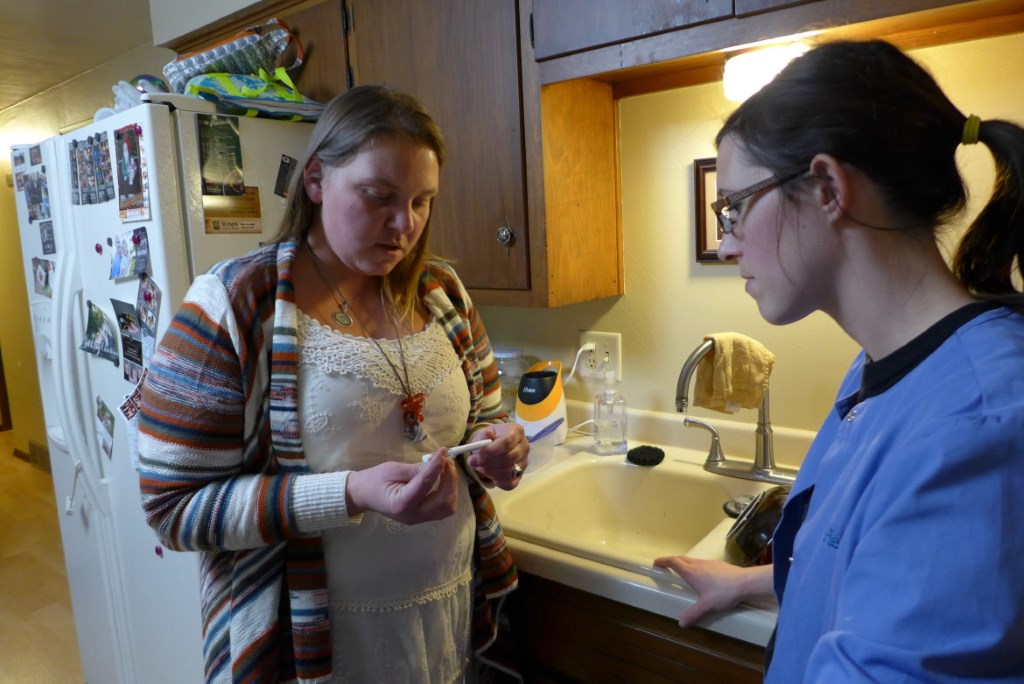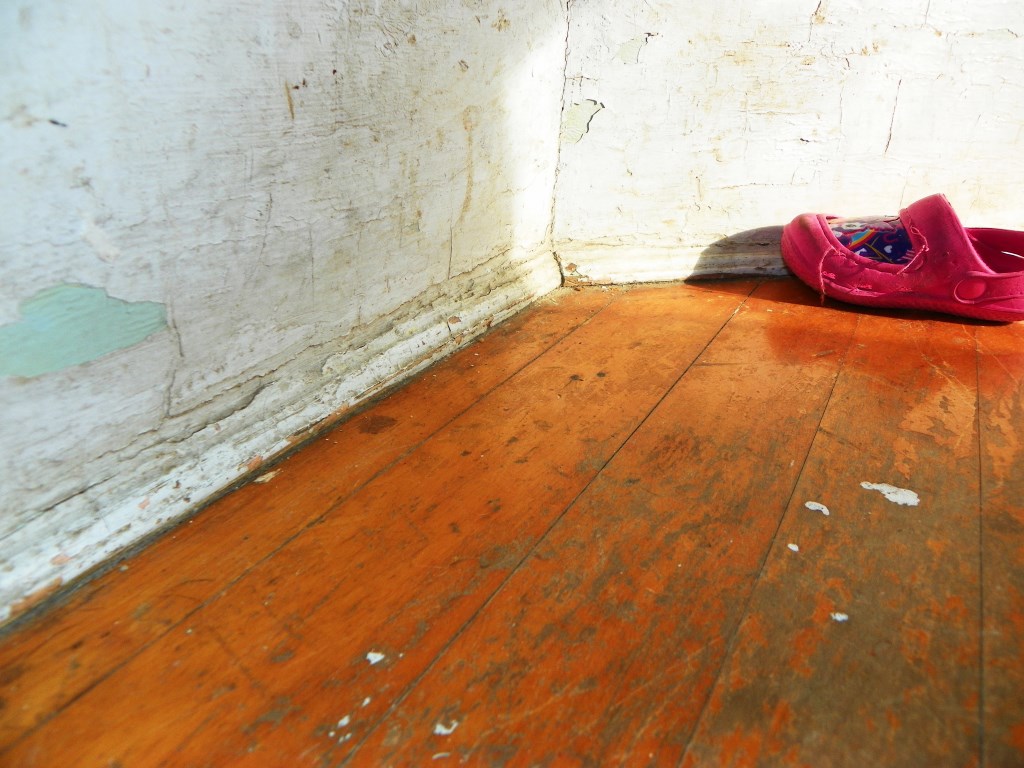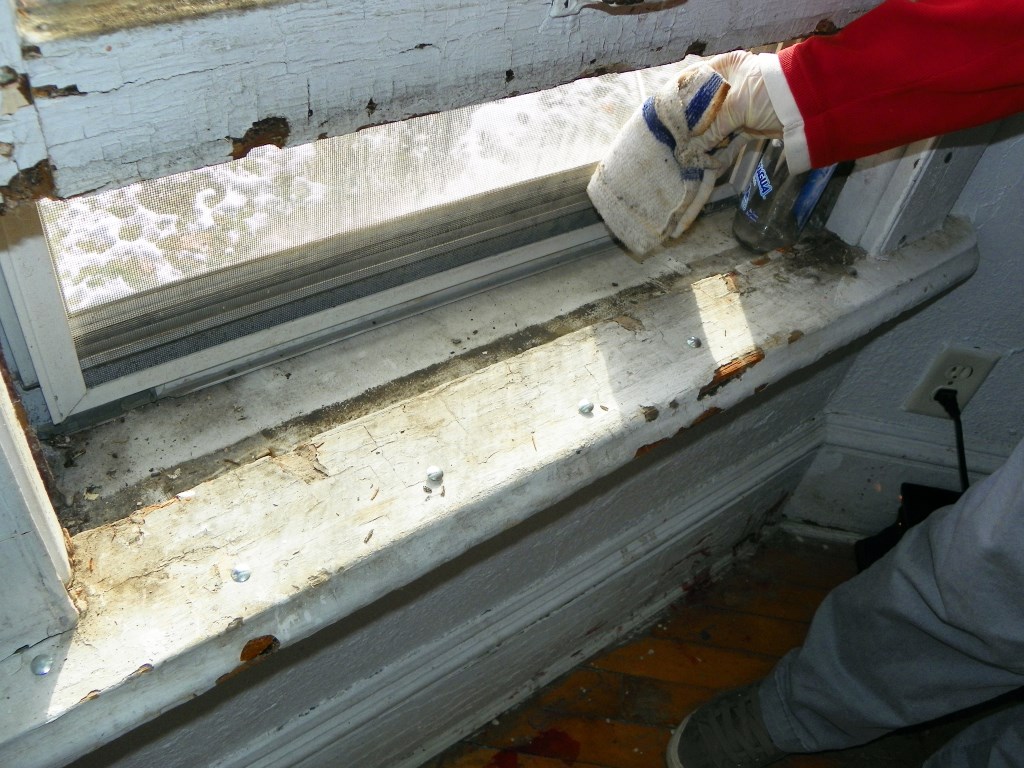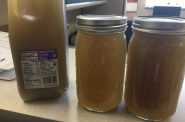State’s Drinking Water Has Lead Dangers
Percent of lead-poisoned children in Wisconsin nearly as high as in Flint.

Crystal Wozniak, left, shows Green Bay homeowner Jackie Grant how to test her home for lead hazards. After she learned her own son was lead poisoned in 2013, Wozniak made it her mission to spread awareness about the presences of lead in households. “Most moms or families do want to protect their kids and there’s just so many people that don’t know about this hidden hazard and how badly it affects young children,” she said. Photo by Bridgit Bowden of Wisconsin Public Radio.
Lead in drinking water, which has ignited a public health crisis in Flint, Michigan, is largely ignored as a potential contributor to elevated blood lead levels in thousands of Wisconsin children, records and interviews show.
Nearly 4,000 children in Wisconsin were diagnosed with elevated levels of lead in their blood in 2014, though the number has fallen over the years thanks in part to bans on lead in paint and gasoline. Unlike in Flint, however, it is not known to what extent lead in the drinking water contributes to elevated blood lead levels in Wisconsin.
The percentage of lead-poisoned children among those tested in Wisconsin — 4.5 percent — is similar to the 4.9 percent of children diagnosed in 2015 in the Flint region, where state and federal officials have declared a state of emergency over the spike in lead in drinking water and children’s blood.
In Milwaukee, the percentage is even higher: 8.6 percent of children tested in 2014 had blood lead levels above 5 micrograms per deciliter, the level at which children are known to suffer health problems, according to the Wisconsin Department of Health Services.
Even those percentages likely understate the magnitude of the problem, said Marc Edwards, the Virginia Tech professor and MacArthur “genius grant” recipient whose team helped identify the lead problem in Flint’s water. Standard testing for lead in blood begins around age 1, a time when children become mobile and may be exposed to lead paint or dust — ignoring infants on formula who may be ingesting large amounts of lead-tainted tap water.
“Neither in Flint nor in Wisconsin is the greatest at-risk group being tested,” Edwards said.

Lead poisoning of children has largely been tied to contact with old, peeling paint containing lead. But experts say children can ingest lead through water and that regulatory agencies do not pay enough attention to that threat. Photo by Matt Campbell of the Wisconsin Center for Investigative Journalism.
Lead’s effects are severe and permanent. Reduced intelligence, learning disabilities and developmental delays have all been attributed to lead exposure in young children, particularly those under age 6 whose developing brains are most vulnerable.
Some studies have linked childhood lead poisoning to disruptive behavior at school and a greater likelihood of violent crime in adulthood. Lead exposure in pregnant women has been associated with an increased risk of fetal death.
The U.S. Environmental Protection Agency acknowledged the contribution of water to the nation’s lead exposure in 1991 when it estimated that drinking water accounts for about 20 percent of average lead exposure, but as much as 85 percent of exposure for infants consuming formula made with tap water.
Because of the dangers of lead, the United States started phasing out leaded gasoline in 1973 until it was virtually eliminated in 1988. The use of lead-based paints steadily decreased after 1950 until the additive was banned from the market in 1978. The use of lead for plumbing was outlawed in 1986, although until January 2014, “lead-free” indoor plumbing components could legally contain up to 8 percent lead.

Old, peeling paint, seen in this windowsill in a rental property in Milwaukee, is often blamed for lead poisoning in children. But experts and advocates point out that lead from aging pipes also can make its way into drinking water, providing another avenue of lead exposure. Photo by Matt Campbell of the Wisconsin Center for Investigative Journalism.
Officials at the nation’s Centers for Disease Control and Prevention and Wisconsin’s Childhood Lead Poisoning Prevention Program attribute childhood lead exposure almost exclusively to deteriorating lead-based paint and lead dust in older homes.
But lead paint is not the only hazard of old housing stock. For decades beginning in the late 1800s, lead was a commonly used material in the pipes that carry drinking water from the water main to individual homes, also known as lead service lines. There are an estimated 176,000 such lead pipes in Wisconsin, where greatly elevated levels of lead of at least 100 parts per billion — or more than six times the federal safety level — have been detected in public water systems in 24 of the 72 counties.
Yanna Lambrinidou, a researcher and instructor at Virginia Tech, said the CDC and public health community are “doing tremendous damage” by failing to require testing for lead in drinking water when a child is lead poisoned.
“It’s putting generations of kids in harm’s way for absolutely no good reason,” she said.
A study led by Dr. Mona Hanna-Attisha, the Flint pediatrician who sounded the alarm about elevated blood lead levels among children in her community, described the crisis as a warning to other communities with aging water infrastructure and limited budgets.
“The situation in Flint, Michigan,” Hanna-Attisha and her research colleagues concluded, “may be a harbinger for future safe drinking-water challenges.”
Article Continues - Pages: 1 2
Tainted Water
-
Fecal Microbes In 60% of Sampled Wells
 Jun 12th, 2017 by Coburn Dukehart
Jun 12th, 2017 by Coburn Dukehart
-
State’s Failures On Lead Pipes
 Jan 15th, 2017 by Cara Lombardo and Dee J. Hall
Jan 15th, 2017 by Cara Lombardo and Dee J. Hall
-
Lax Rules Expose Kids To Lead-Tainted Water
 Dec 19th, 2016 by Cara Lombardo and Dee J. Hall
Dec 19th, 2016 by Cara Lombardo and Dee J. Hall






















This article does not address the variable in question, which is lead laterals. For the most part, lead in the drinking water supply is discussed, but that does not include the laterals. From a scientific method perspective, this article does almost nothing to convince me that laterals that are chemically treated have higher lead concentrations than non-lead laterals.
The article does acknowledge this information is not widely available. Is it not then reasonable that the water supply, while a scary scenario, is not really the likely source of lead? Especially in communities that treat their water like we do?
The DC study shows how lead in water IS dangerous. What no available information shows is that lead laterals are the problem. Per the Milwaukee Water Works in their article in the JS, lead levels in lead lateral homes was within acceptable limits within a week or two of disturbing the lateral.
I’m not dismissing this issue, but there is some scaring of the public going on here with lead laterals.
Lead and other heavy metals like tin, mercury, and aluminum have no use in the human body and cause damage in many ways. There are thousands of lead laterals in Milwaukee’s distribution system in older parts of the city. Lake Michigan pH levels are neutral and above and less chemically reactive at leaching lead from the lateral tubing. As a precaution, always run water for a minute or more, until cold, before using for drinking, making coffee. This removes the overnight standing water in the laterals and plumbing and fittings.
Children, babies, and pregnant women, are the most susceptible to lead risks since they have smaller bodies. They are closer to the ground as well. Living in a pre-1978 home with decaying dusty lead paint is the highest risk. Windows, doorways, and porches are the risky areas. Children play around these areas and can pick up the dust on hands, and put hands in their mouths, leading to higher doses. Use of a HEPA vacuum and wet wiping areas lowers the risk in an older home.
The Sistine Chapel is painted with lead coating. No one is calling for removal of this painting.
Nutrition plays a role in lead poisoning. A child that has a good diet with calcium helps prevent higher lead doses. Lead readily substitutes for calcium where it is needed in the body. Adults can be poisoned as well. Always wash hands before handling food and eating.
The natural lead in soil levels is around 50 ppm. The base of older pre-1978 housing and garages can be much higher levels of lead in soil, due to flaking lead paint over the decades. Along road ways and freeways, the levels in soil are likely higher due to the prevalence of lead in gasoline years ago. Children playing in soil can lead to poisoning, and adults growing vegetable gardens in high level lead soils can lead to accumulations in humans.
While concerns over lead poisoning are valid, the author’s alarmist discussion about lead laterals leaves out some important points… Those lead pipes have been in use for many years and are coated with rust and deposits that prevent the water from coming into contact with the lead. What happened in Flint was that the switch to corrosive river water removed these deposits, allowing lead to leach into the water. Unless the laterals have been disturbed, as was happening in Milwaukee with new mains being installed, lead should remain at negligible levels. The article did not mention that the water in a home that has lead laterals is most likely very safe.
30 years ago I noticed the lateral to my first home in Sheboygan was of lead pipe, and had it tested. It was fine, and I was given this explanation. If you have an older home with dark-colored pipe leading to the meter, do the magnet test, and if it’s lead don’t panic, just get it tested.